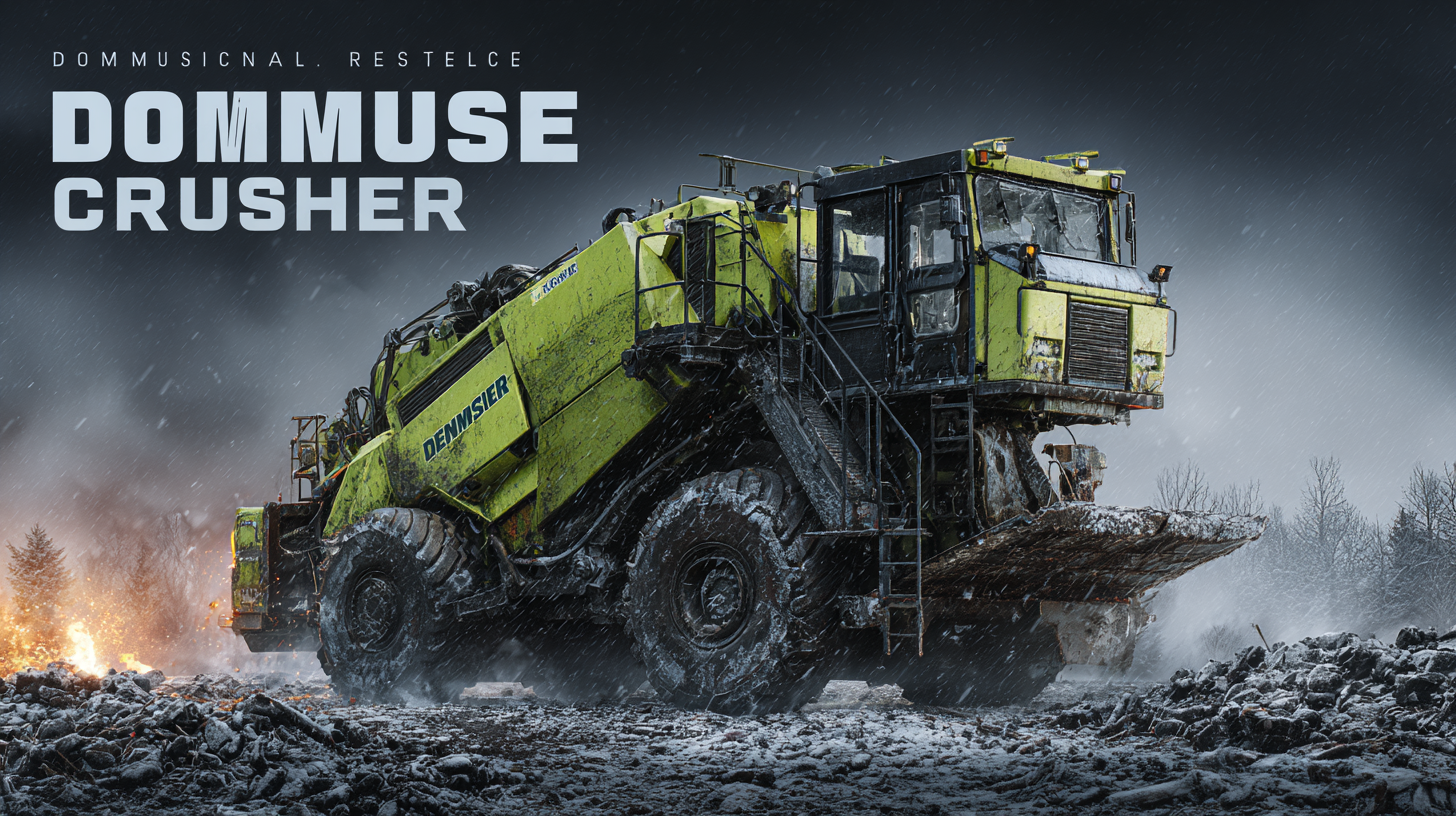In today's rapidly urbanizing world, effective waste management solutions are increasingly crucial for sustainable living. The global waste generation is projected to reach 3.4 billion tons by 2050, with a significant portion comprising easily manageable domestic refuse. Among the innovative technologies designed to tackle this challenge, the Domestic Refuse Crusher stands out as a vital tool that can enhance waste disposal practices in households. As indicated in a report by the World Bank, proper waste management can significantly reduce environmental pollution and landfill overflows, providing a more sustainable urban ecosystem. This blog aims to explore how to identify quality suppliers for Domestic Refuse Crushers, offering insights into selecting the most efficient and reliable options that can meet the diverse needs of modern waste management.

When exploring various types of domestic refuse crushers for home use, it’s essential to recognize the different models available and their unique features. According to a recent industry report by IBISWorld, the market for waste disposal and management is projected to reach $100 billion by 2027, underscoring the need for efficient home waste management solutions. Among the most popular crusher types are the compact models designed for small kitchens, which can handle food scraps, while larger models are capable of grinding various materials, including plastics and metals.
Moreover, the durability and operational efficiency play a vital role in choosing the right crusher for your home. A study from Waste Management World indicated that homes equipped with efficient refuse crushers can reduce their waste volume by up to 50%. This not only aids in minimizing landfill contributions but also promotes sustainability. With the integration of advanced technologies, modern crushers often feature noise-reduction mechanisms and energy-efficient motors, enhancing their appeal for domestic use. As households become more aware of their environmental impact, investing in a refuse crusher can serve as a practical step towards effective waste management.
When it comes to efficient waste management, the choice between electric and manual refuse crushers plays a crucial role. Electric refuse crushers offer a high level of convenience, allowing users to process large quantities of waste quickly and with minimal effort. These machines typically have powerful motors that can handle tougher materials, making them ideal for households that generate a significant amount of refuse. Additionally, the automation reduces the physical strain on users, promoting a safer and more efficient waste disposal process.
On the other hand, manual refuse crushers can be an economical choice for those who prioritize low-cost solutions or generate less waste. These devices require physical effort to operate, which can be a deterrent for some. However, they provide the advantage of being simple to use and lacking the need for electricity, making them suitable for off-grid locations or areas with frequent power outages. Manual crushers can also be easier to maintain and typically come at a lower upfront cost, appealing to budget-conscious consumers. Ultimately, the decision between electric and manual refuse crushers hinges on individual needs and the specific waste management challenges faced.
| Type | Power Source | Processing Capacity (kg/h) | Noise Level (dB) | Energy Consumption (kWh) | Price ($) |
|---|---|---|---|---|---|
| Electric Crusher | Electricity | 300 | 70 | 1.2 | 150 |
| Manual Crusher | Manual | 100 | 50 | 0.0 | 30 |
| Commercial Electric Crusher | Electricity | 500 | 80 | 2.5 | 500 |
| Battery-Powered Crusher | Battery | 200 | 60 | 1.5 | 200 |
When it comes to managing domestic waste, the choice between portable and stationary refuse crushers becomes critical for efficiency and effectiveness.
 Portable waste crushers offer the advantage of mobility, making them ideal for households that generate varying amounts of waste. Their compact design allows users to easily move them around the property, reaching difficult areas without the need for heavy equipment. Additionally, portable crushers can be particularly beneficial for those who engage in DIY projects or have seasonal clean-up needs, as they can be deployed when and where they are most necessary, minimizing the accumulation of refuse.
Portable waste crushers offer the advantage of mobility, making them ideal for households that generate varying amounts of waste. Their compact design allows users to easily move them around the property, reaching difficult areas without the need for heavy equipment. Additionally, portable crushers can be particularly beneficial for those who engage in DIY projects or have seasonal clean-up needs, as they can be deployed when and where they are most necessary, minimizing the accumulation of refuse.
On the other hand, stationary waste crushers provide a more robust solution for households with consistent and larger waste output. Installed in a fixed position, these units often come with greater capacity and power, making them suitable for ongoing waste management needs. Their design usually integrates seamlessly into home waste disposal systems, offering the ability to handle tougher materials that portable crushers might struggle with. Stationary models are also typically built for longevity, making them a worthy investment for households committed to effective waste management over the long term. Each option has its unique advantages, and the best choice ultimately depends on specific waste generation patterns and management preferences.
In recent years, the demand for efficient waste management solutions has surged, prompting advancements in domestic refuse crushers. One of the most innovative features to look for is the integration of smart technology. Modern refuse crushers are increasingly equipped with sensors that can detect the type and volume of waste, optimizing the crushing process for energy efficiency. According to a report from the Waste Management Association, businesses utilizing smart waste management solutions have reported up to a 30% reduction in operational costs.
Another vital feature is the design of the crushing mechanism itself. Look for crushers that employ dual-shaft shredding technology which enhances the efficiency of waste processing. This mechanism can handle a wider variety of materials as compared to single-shaft models. A study by the International Journal of Waste Management indicated that dual-shaft shredders can process up to 50% more waste per hour than traditional units, making them a preferable choice for both residential and commercial applications. In addition, robust materials used in construction ensure longer product life, further contributing to a sustainable waste management strategy.

The increasing awareness of sustainable waste management has prompted homeowners to seek efficient solutions, with domestic refuse crushers becoming a popular choice. According to a report by the Global Waste Management Market, the demand for waste management solutions is projected to grow at a compound annual growth rate (CAGR) of 5.5% from 2021 to 2028. This trend reflects not only the rise in urbanization but also a shift towards eco-friendly practices, underscoring the cost-effectiveness of employing domestic crushers.
Investing in a domestic refuse crusher can significantly reduce waste volume, which in turn minimizes disposal costs. The Environmental Protection Agency (EPA) reports that food waste alone accounts for approximately 22% of municipal solid waste. By using crushers, households can reduce this volume and lower the frequency of waste collection, leading to savings in both costs and carbon emissions associated with transportation. Furthermore, when waste is disposed of in a more efficient manner, it not only supports sustainable habits but also contributes to the generation of compost, enriching the soil and promoting circular economy principles. This dual benefit of cost savings and sustainable waste management makes domestic crushers an economically viable investment for many households.
